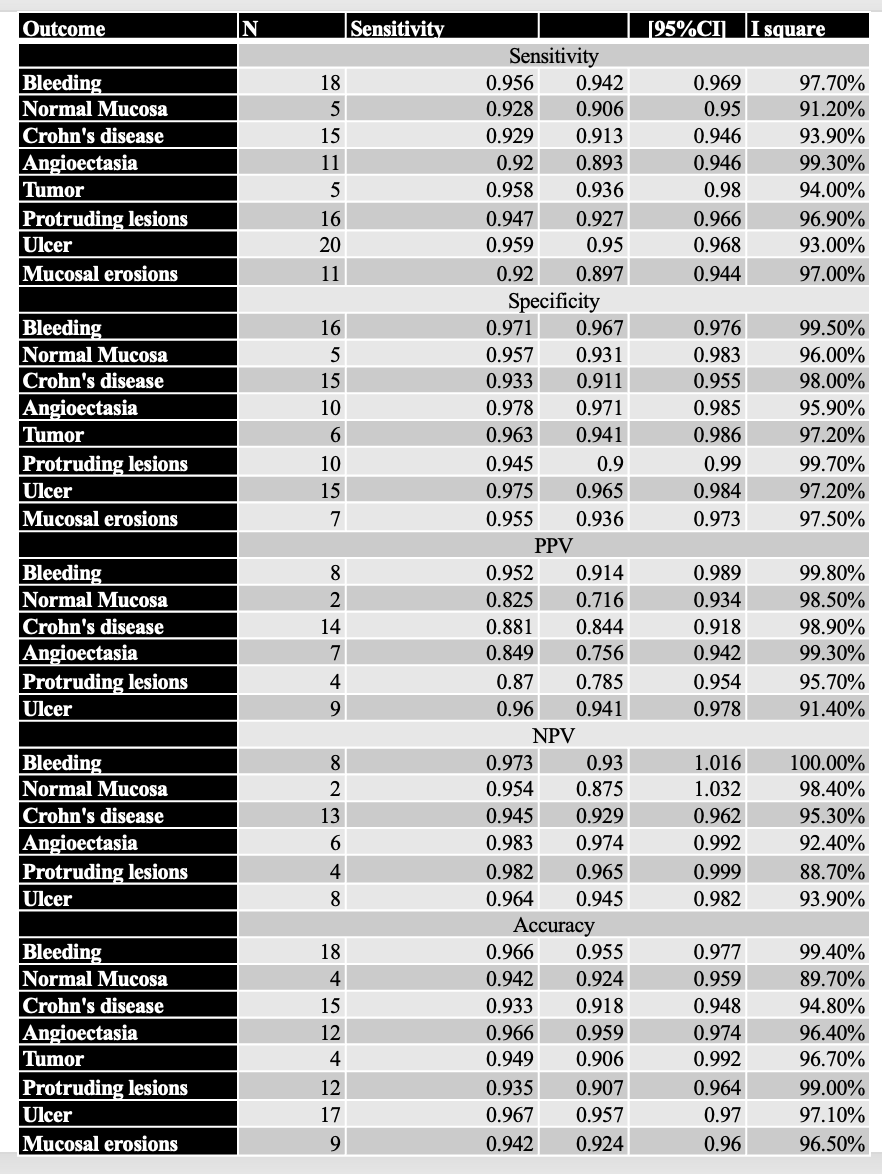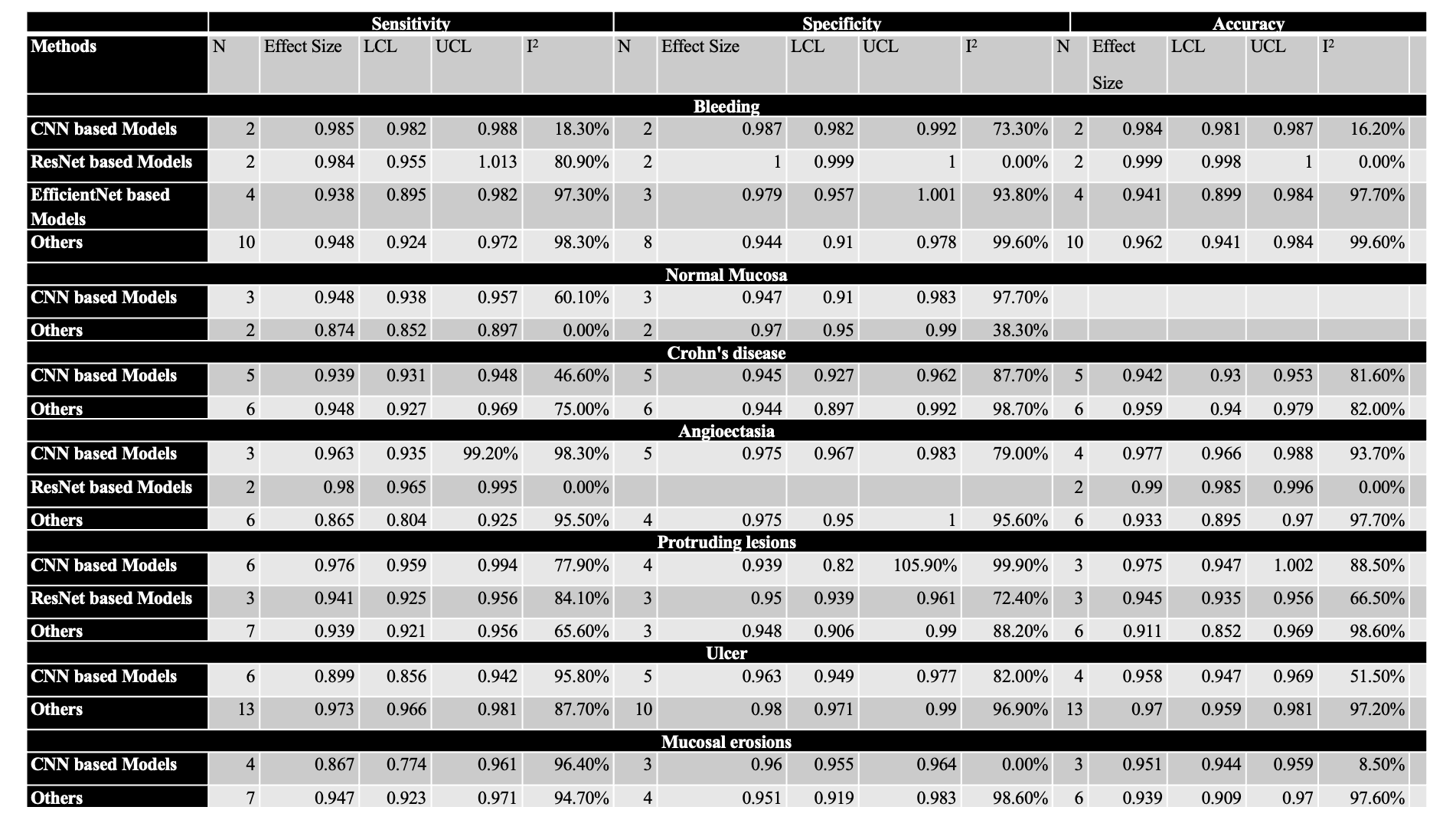Monday Poster Session
Category: Small Intestine
P4065 - Performance of Artificial Intelligence Algorithms in Small Bowel Lesion Detection Using Video Capsule Endoscopy: A Meta-Analysis
Monday, October 27, 2025
10:30 AM - 4:00 PM PDT
Location: Exhibit Hall

Shivangini Duggal, MD
Department of Internal Medicine at Paul L. Foster School of Medicine, Texas Tech University Health Sciences Center, El Paso TX, USA
El Paso, TX
Presenting Author(s)
Shivangini Duggal, MD1, Lakshmi Kattamuri, MD2, Alok K. Dwivedi, PhD2, Ahmed Shakeel, PhD2, Sherif E. Elhanafi, MD2, Marc J. Zuckerman, MD3
1Department of Internal Medicine at Paul L. Foster School of Medicine, Texas Tech University Health Sciences Center, El Paso TX, USA, El Paso, TX; 2Texas Tech University Health Sciences Center, El Paso, TX; 3Division of Gastroenterology, Department of Internal Medicine, Texas Tech University Health Sciences Center, El Paso, TX., El Paso, TX
Introduction: Video capsule endoscopy (VCE) offers a low-risk, noninvasive approach to visualize the gastrointestinal tract, capturing ~60,000 images per exam. While VCE plays a key role in evaluating small bowel bleeding, its diagnostic yield remains suboptimal (35%–77%), and interpretation is labor-intensive. Several artificial intelligence (AI) algorithms, particularly convolutional neural networks (CNNs), have shown promising accuracy by automatically extracting complex hierarchical features directly from image data. However, their clinical applicability remains uncertain. In this meta-analysis, we aimed to systematically evaluate and compare the diagnostic performance of AI algorithms, especially CNN-based models, for detecting small bowel lesions on VCE.
Methods: A comprehensive search of Embase, Medline, PubMed, and Google Scholar was conducted through February 2025 for studies evaluating AI-based algorithms for lesion detection in VCE. The primary outcome assessed pooled performance across various small bowel lesions. Subgroup analysis compared CNN-based versus non-CNN methods. Meta-analyses were performed using random-effects models in Stata 17.
Results: Sixty-three studies were included. Pooled sensitivity was highest for ulcers (0.959; 95% CI 0.950–0.968), bleeding (0.956; 95% CI 0.942–0.969), and tumors (0.958; 95% CI 0.936–0.980). Specificity was highest for angioectasia (0.978; 95% CI 0.971–0.985) and ulcers (0.975; 95% CI 0.965–0.984). Positive predictive values were highest for ulcers (0.960; 95% CI 0.941–0.978), while negative predictive values were highest for angioectasia (0.983; 95% CI 0.974–0.992). Accuracy exceeded 0.93 for most lesions, with highest accuracy for ulcers (0.967; 95% CI 0.957–0.970) (Table 1). Subgroup analysis showed CNN-based models achieved superior sensitivity for bleeding (0.985; 95% CI 0.982–0.988), while ResNet variants performed best for angioectasia (sensitivity 0.980; 95% CI 0.965–0.995). CNN-based algorithms generally showed higher sensitivity for bleeding, Crohn’s disease, and protruding lesions compared with non-CNN methods, though heterogeneity remained high (I² >80%) (Table 2).
Discussion: AI algorithms, especially CNN architectures, demonstrate excellent performance in small bowel lesion detection via VCE, with highest accuracy for ulcers and bleeding. However, significant heterogeneity highlights the need for standardized datasets and external validation before widespread clinical adoption.

Figure: Table 1: Pooled performance of AI based methods for different study outcomes (targets)

Figure: Table 2. Comparison of pooled performance by AI methods used for prediction for different targets
Disclosures:
Shivangini Duggal indicated no relevant financial relationships.
Lakshmi Kattamuri indicated no relevant financial relationships.
Alok Dwivedi indicated no relevant financial relationships.
Ahmed Shakeel indicated no relevant financial relationships.
Sherif Elhanafi indicated no relevant financial relationships.
Marc Zuckerman indicated no relevant financial relationships.
Shivangini Duggal, MD1, Lakshmi Kattamuri, MD2, Alok K. Dwivedi, PhD2, Ahmed Shakeel, PhD2, Sherif E. Elhanafi, MD2, Marc J. Zuckerman, MD3. P4065 - Performance of Artificial Intelligence Algorithms in Small Bowel Lesion Detection Using Video Capsule Endoscopy: A Meta-Analysis, ACG 2025 Annual Scientific Meeting Abstracts. Phoenix, AZ: American College of Gastroenterology.
1Department of Internal Medicine at Paul L. Foster School of Medicine, Texas Tech University Health Sciences Center, El Paso TX, USA, El Paso, TX; 2Texas Tech University Health Sciences Center, El Paso, TX; 3Division of Gastroenterology, Department of Internal Medicine, Texas Tech University Health Sciences Center, El Paso, TX., El Paso, TX
Introduction: Video capsule endoscopy (VCE) offers a low-risk, noninvasive approach to visualize the gastrointestinal tract, capturing ~60,000 images per exam. While VCE plays a key role in evaluating small bowel bleeding, its diagnostic yield remains suboptimal (35%–77%), and interpretation is labor-intensive. Several artificial intelligence (AI) algorithms, particularly convolutional neural networks (CNNs), have shown promising accuracy by automatically extracting complex hierarchical features directly from image data. However, their clinical applicability remains uncertain. In this meta-analysis, we aimed to systematically evaluate and compare the diagnostic performance of AI algorithms, especially CNN-based models, for detecting small bowel lesions on VCE.
Methods: A comprehensive search of Embase, Medline, PubMed, and Google Scholar was conducted through February 2025 for studies evaluating AI-based algorithms for lesion detection in VCE. The primary outcome assessed pooled performance across various small bowel lesions. Subgroup analysis compared CNN-based versus non-CNN methods. Meta-analyses were performed using random-effects models in Stata 17.
Results: Sixty-three studies were included. Pooled sensitivity was highest for ulcers (0.959; 95% CI 0.950–0.968), bleeding (0.956; 95% CI 0.942–0.969), and tumors (0.958; 95% CI 0.936–0.980). Specificity was highest for angioectasia (0.978; 95% CI 0.971–0.985) and ulcers (0.975; 95% CI 0.965–0.984). Positive predictive values were highest for ulcers (0.960; 95% CI 0.941–0.978), while negative predictive values were highest for angioectasia (0.983; 95% CI 0.974–0.992). Accuracy exceeded 0.93 for most lesions, with highest accuracy for ulcers (0.967; 95% CI 0.957–0.970) (Table 1). Subgroup analysis showed CNN-based models achieved superior sensitivity for bleeding (0.985; 95% CI 0.982–0.988), while ResNet variants performed best for angioectasia (sensitivity 0.980; 95% CI 0.965–0.995). CNN-based algorithms generally showed higher sensitivity for bleeding, Crohn’s disease, and protruding lesions compared with non-CNN methods, though heterogeneity remained high (I² >80%) (Table 2).
Discussion: AI algorithms, especially CNN architectures, demonstrate excellent performance in small bowel lesion detection via VCE, with highest accuracy for ulcers and bleeding. However, significant heterogeneity highlights the need for standardized datasets and external validation before widespread clinical adoption.

Figure: Table 1: Pooled performance of AI based methods for different study outcomes (targets)

Figure: Table 2. Comparison of pooled performance by AI methods used for prediction for different targets
Disclosures:
Shivangini Duggal indicated no relevant financial relationships.
Lakshmi Kattamuri indicated no relevant financial relationships.
Alok Dwivedi indicated no relevant financial relationships.
Ahmed Shakeel indicated no relevant financial relationships.
Sherif Elhanafi indicated no relevant financial relationships.
Marc Zuckerman indicated no relevant financial relationships.
Shivangini Duggal, MD1, Lakshmi Kattamuri, MD2, Alok K. Dwivedi, PhD2, Ahmed Shakeel, PhD2, Sherif E. Elhanafi, MD2, Marc J. Zuckerman, MD3. P4065 - Performance of Artificial Intelligence Algorithms in Small Bowel Lesion Detection Using Video Capsule Endoscopy: A Meta-Analysis, ACG 2025 Annual Scientific Meeting Abstracts. Phoenix, AZ: American College of Gastroenterology.
